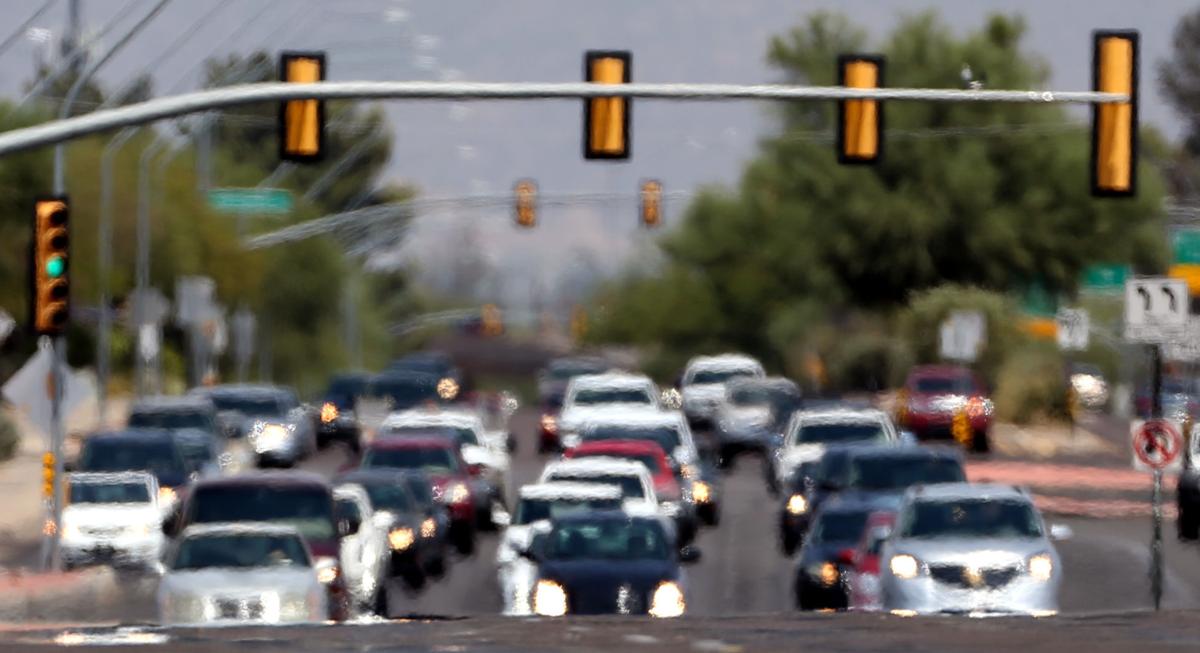The Tucson metro area’s air is suffering its worst ozone pollution since 2012.
The region has exceeded federal standards for ground-level ozone five times this year, and eastern Pima County’s ozone season is not quite half-finished. It typically lasts from April through October.
On those days, ozone levels at a county air monitor at Saguaro National Park-East topped the federal standard of 70 parts per billion ozone. That’s been the standard since the Environmental Protection Agency lowered it from 75 parts per billion in September 2015.
Ozone, created by a mixture of air emissions that occurs during intense sunlight, can trigger a variety of health problems. Effects are particularly acute for children and the elderly, and people of all ages who suffer from asthma or otherwise have sensitive lungs, EPA says.
It can cause chest pain, coughing, throat irritation, and airway inflammation, reduce lung function, harm lung tissue and worsen bronchitis and emphysema, EPA has said. Ozone can also have harmful effects on sensitive vegetation and ecosystems.
Pima County officials say they don’t know for sure why the ozone levels are so high this year. But typically, extended high-pressure weather systems of the kind now occurring here are a major cause, along with intense solar radiation, said Beth Gorman, a Pima County Department of Environmental Quality program manager.
Heat also is a factor, but it’s not typically as important, she said. For instance, the air exceeded the ozone standard twice last week but not this week so far despite a run of record and near-record high temperatures.
The air most recently topped the standard June 15, when levels of the compound exceeded the federal standard at all eight county ozone air monitors. Typically, the Saguaro Park monitor has the highest readings, as it did that day with 77 parts per billion. The ozone level exceeded the standard in four of the remaining monitors at various other times this year.
This year’s high readings put the county’s air on the edge of violating EPA standards, although a determination of whether it’s in violation may not come for some time.
“We’re absolutely concerned about this. It comes back to public health. If we’re close to the standard, presuming it was set on the latest health information, if we are exceeding it, it means people are breathing air not as clean as it should be,” said Ursula Nelson, the Pima County Department of Environmental Quality director.
Since motor vehicles are typically the biggest source of this area’s air pollution, the county encourages people to lessen their driving during ozone-prone periods such as the current one, she said.
“We encourage people to not drive using single-occupancy vehicles, and to minimize driving through car pools, trip combining and cleaner fuels,” Nelson said.
The county has issued nine air quality advisories for ozone this year, most recently on Tuesday. The advisories are aimed at letting people know that ground-level ozone concentrations are elevated, and could cause some people breathing problems.
During advisory periods, people whose lungs are sensitive to ozone may want to limit outside exertion until evening hours, when levels of ozone pollution should begin to decrease, the county environmental agency says. That’s because intense outdoor physical activity causes faster and deeper breathing. That allows ozone to penetrate into parts of the lungs that are more likely to be injured.
The county issued only four ozone advisories in 2016. But year to year comparisons aren’t always accurate, the county’s Gorman said. In part, that’s because advisories sometimes try to anticipate ozone levels a few hours ahead, and sometimes those predictions aren’t accurate, she said.
Determining if the county meets the EPA standard relies on air readings over three years. EPA uses a complex formula that averages the fourth highest reading of each year. Pima County’s three-year average including 2017 is now 0.69 parts per billion, Gorman said.
“We’re very close to violating that standard,” Gorman said.
Since the county’s 2015 reading was very good at 0.66 parts per billion, “next year is the year we’re going to have a problem,” after the 2015 level drops out of the calculation used to determine compliance, she said.
But legal uncertainties make the county’s chances of being in or out of compliance highly unclear.
First, EPA Administrator Scott Pruitt announced early this month that the agency will delay its determination of whether local areas are meeting the new standard from October 2017 to October 2018.
In addition, the Trump administration said in April that it’s going to review the recently enacted ozone standard. It’s been sharply criticized as excessively strict by many business groups but praised by environmental groups. Both these issues are almost certain to be settled in court.
The U.S. Chamber of Commerce has argued that enforcement of the stricter new ozone standards could create “no growth zones” across the country because failure to comply can trigger sanctions such as cutoffs of federal highway money or stricter regulations on new industry.
But during the Obama administration, the EPA countered that public health benefits of tightening the ozone standard, estimated at $2.9 billion to $5.9 billion annually, would outweigh its costs. It estimated those at $1.4 billion a year.
For now, the county’s Gorman hopes for a good monsoon season this year, which would hold down summertime ozone levels.
“If we get a good monsoon, which happened last year, a pretty active monsoon with lots of cloud cover and low pressure coming through, that would be great,” Gorman said.





